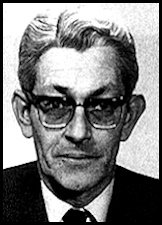CounterIntelligence Chief James J. Angleton
JAMES JESUS ANGLETON
He was born in Idaho amid nineteen seventeen to James and Carmen Angleton with a middle name chosen to credit his Mexican heritage. The Angleton children were raised lavishly within Italy and the US to accommodate his father’s role in various lucrative commerce projects. Amongst the nineteen thirties James enrolled at preparatory school in England and later attended Yale before the end of nineteen thirty-seven. During nineteen forty-three Angleton graduated from college, left continued schooling to join the US Army, and was enlisted by the Office of Strategic Services (OSS). He was assigned to the OSS Counterespionage division X-2 within occupied Italy and undertook projects to recruit contacts, use Italian organized crime groups to combat Fascists, and gather informants for Allied operations. James Angleton’s successful operations amidst WWII led to his appointment as Counterintelligence Chief of Italy but the OSS was disbanded after combat ceased. Following multiple organizational revisions it became the Central Intelligence Agency and James Angleton was present at its official formation.
Only some intelligence officers survived the multiple organizational intelligence transitions but among those handful was James Angleton. Now serving the CIA from Italy, he allied with the Christian Democratic Party to defeat the Communist Party groups in Italy’s first postwar elections. Angleton served under multiple Agency Directors but Allen Dulles was among his closest professional relationships. He reportedly spent years bugging varying locations in Washington DC that included the homes of some CIA employees, and viable information gathered was submitted to Dulles. By nineteen fifty-three, James was leading the Special Projects unit within the Foreign Intelligence Division of the CIA and developing confidential intelligence channels with the Federal Bureau of Investigation. Angleton was appointed the Agency’s Chief of Counterintelligence during the middle of the nineteen-fifties in reward for his loyalty, successful missions, and devout anti-Soviet bearing. The new counterintelligence chief began to amass significant power that grew after James was entrusted to control all Israeli operations via the counterintelligence staff.
In his spare time Angleton cultivated rare orchids, enjoyed fly fishing, was an amateur gemologist, and each pastime added to his spymaster mystique. Such undertakings required patience, extreme care, and constant monitoring which all lent themselves to his chosen profession. James would craft specialty lures, jewelry for his friends, and created multiple types of orchids with one bearing the name of his wife Cecily. Such endeavors featured the significant intelligence and seemingly limitless patience Angleton could exhibit while undertaking such delicate procedures. Conversely, he was noted to excessively drink and smoke with abandon when contriving his plans for the counterintelligence section within the CIA’s Directorate of Plans. By the close of the nineteen fifties Angleton would be convinced the Agency was harboring an unknown penetration agent called a mole due to other Western intelligence groups having been struck by such traitors.
Amidst nineteen sixty-one his beliefs were reinforced by defector Anatoliy Golitsyn and unlike other defectors who Angleton rebuffed or ignored, Golitsyn was taken very seriously. The defector was given access to secret files, employee records, and his allegations were part of the reason the Counterintelligence Special Investigations Group (CISIG) was formed. As the sixties rolled on Golitsyn claims offered Angleton the chance to expand his staff from dozens to hundreds of agents and employees to hunt for traitors. The counterintelligence leader was at that point was seemingly less powerful than Agency division chiefs but in practice his influence far exceeded most others in the CIA. Angleton’s suspicions reached a fevered pitch when his repeated prior luncheon guest Harold “Kim” Philby fled to Moscow in the course of nineteen sixty-three after he was proven to be a Soviet mole. Philby’s specter and Soviet counterintelligence position for Britain's Secret Intelligence Service (MI6) would partially set the parameters for CIA employees targeted in the later mole hunts. Under the influence of Angleton with Golitsyn’s advice, most targets focused on by CISIG were in the Agency’s Soviet division or related to the same division’s operations.
Angleton Following his Agency Career
As the mole hunt raged for decades several CIA employees were fired or quit under duress, hundreds were transferred, multiple defectors were lost, and one KGB traitor was even imprisoned for years illegally based on the unverified allegations of Golitsyn or CISIG. The hunting further spread based on related Golitsyn allusions to multiple other nations and each was approved of by the CIA’s counterintelligence leader. Yet with the dawn of the nineteen seventies Angleton’s power base eroded due to repeated allied CIA Directors being dismissed, the enemies he acquired from mole hunt’s related allegations, and his repeated abuses of power. Agency Director William Colby in time slashed the counterintelligence staff, removed Angleton's control of Israeli operations, and ultimately dismissed him from the CIA during nineteen seventy-four to account for his years of unauthorized operations. Ironically, before Angleton’s dismissal one of his own CISIG officers charged James with being the elusive mole they sought, yet similar to their other allegations, this claim has no verifiable evidence to support it.





